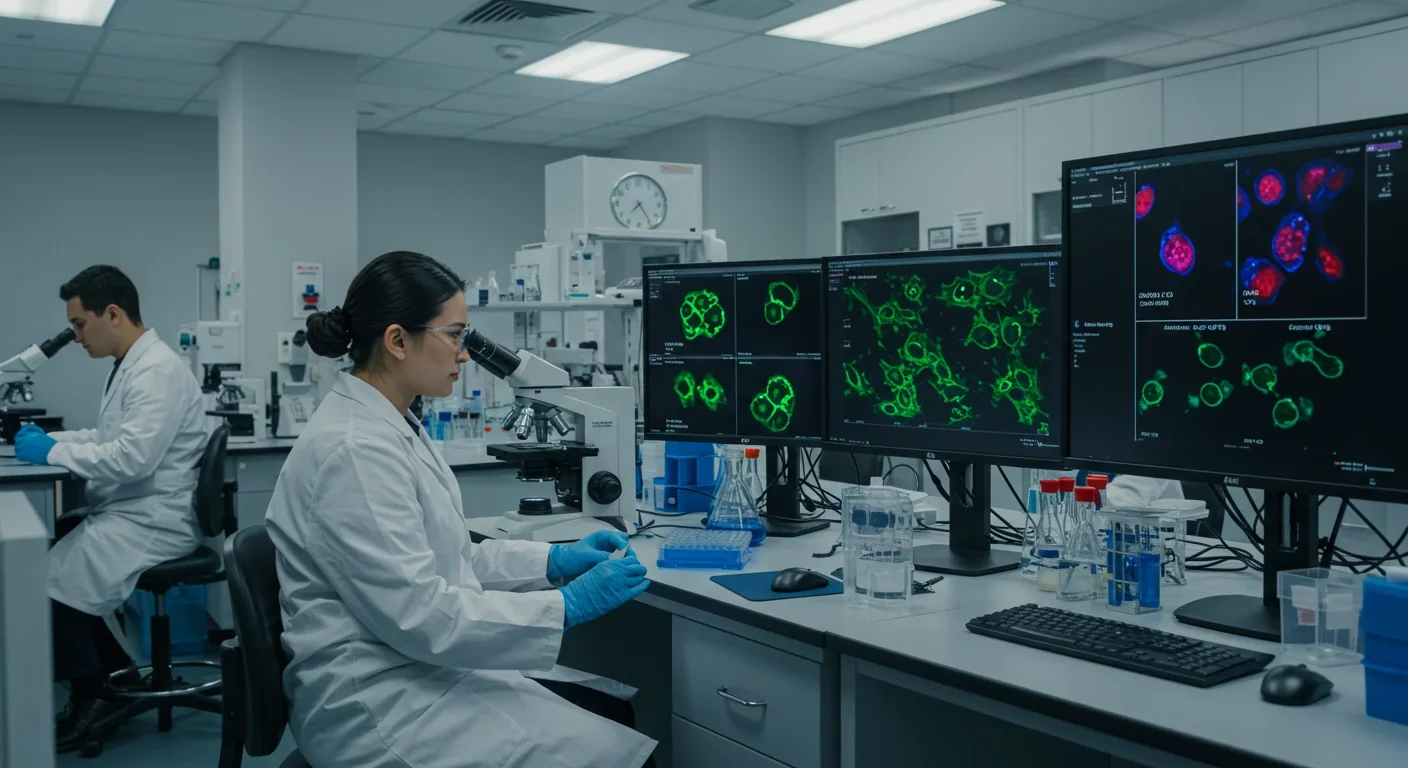Epigenetic Clocks Predict Disease 30 Years Early

TL;DR: Senolytic drugs selectively eliminate zombie cells that accumulate with age, showing breakthrough results in human trials for cancer treatment and metabolic health.

By 2035, scientists predict that a trip to your doctor might include a prescription for drugs that hunt down and eliminate the damaged cells making you age. What sounds like science fiction is already happening in clinical trials worldwide. These drugs, called senolytics, work by selectively destroying "zombie cells" that accumulate as you age, and they're challenging everything we thought we knew about growing old.
Your body constantly replaces old cells with new ones. It's an elegant system, except when it breaks down.
Senescent cells are damaged cells that stopped dividing but refuse to die. Scientists call them zombie cells because they enter a bizarre undead state. They can't function properly, but they won't trigger the self-destruct sequence that normally eliminates broken cells.
Instead, these cells stick around and make everything worse. They pump out inflammatory proteins and toxic molecules through what researchers call the senescence-associated secretory phenotype, or SASP. Think of it as a distress signal that never stops broadcasting, poisoning nearby healthy cells.
In young bodies, the immune system efficiently clears these troublemakers. But as you age, zombie cells accumulate faster than your body can eliminate them. They gather in joints, lungs, blood vessels, and brain tissue. Research shows the vasculature develops the greatest senescent cell burden, which helps explain why cardiovascular disease correlates so strongly with age.
The damage compounds over time. Reactive oxygen species from dysfunctional mitochondria activate inflammatory pathways, upregulating factors like IL-6 and IL-8. Each zombie cell creates a microenvironment of chronic inflammation that spreads to neighboring cells.
A 20-year-old might have barely any senescent cells. A 60-year-old could have billions.
Here's where it gets interesting. Zombie cells have survival mechanisms that protect them from the body's natural cleanup processes. They rely on specific anti-apoptotic pathways, essentially molecular shields. Senolytics work by disabling these shields.
The breakthrough came in 2015 when researchers at Mayo Clinic and Scripps Research first identified compounds that could selectively eliminate senescent cells. The most studied combination is dasatinib and quercetin, often called D+Q.
Dasatinib, originally developed as a cancer drug, targets specific tyrosine kinase proteins that senescent cells use to stay alive. Quercetin, a natural compound found in onions and apples, hits different survival pathways. Together, they create what scientists call "synthetic lethality." Neither drug alone might kill the senescent cell, but the combination overwhelms its defenses.
Healthy cells can withstand this assault because they don't rely as heavily on those specific survival pathways.
Modern AI-powered approaches are now identifying new senolytic compounds. An attention-based neural network called SenolyticSynergy recently screened over 1,900 potential drug pairings, identifying 190 high-confidence combinations. The top candidate, temsirolimus combined with nitazoxanide, scored even higher than D+Q for synergistic effects.
Animal results looked promising. Mice treated with senolytics didn't just live longer, they lived better. Studies showed improvements in healthspan, the period of life spent in good health.

But humans aren't just big mice. The real test comes in clinical trials.
Mayo Clinic has led multiple trials testing senolytics in conditions like idiopathic pulmonary fibrosis. Results have been mixed but promising. Some patients showed improvements in physical function and reduced inflammation.
The most dramatic results came from cancer research. In the COIS-01 trial, researchers combined senolytics with immunotherapy for treating head and neck cancer. The combination achieved a 33.3% major pathological response rate with remarkably low toxicity. Only one out of 24 patients experienced serious side effects, compared to over half in conventional treatment.
The mechanism proved fascinating. Senescent immune cells were helping tumors evade detection. By clearing these aged immune cells, senolytics essentially rejuvenated patients' immune systems.
Recent trials in type 2 diabetic patients showed improvements in metabolic markers and reduced inflammation. Participants reported better energy levels and physical function, though effects varied.
This isn't humanity's first attempt to turn back the clock. Ancient Chinese emperors consumed mercury thinking it would grant immortality, which obviously went poorly. Medieval alchemists sought the philosopher's stone. Ponce de León searched Florida for the fountain of youth.
Remember resveratrol? The red wine compound that dominated headlines for years? Larger studies eventually showed minimal effects in humans. The pattern repeats: promising preliminary research, breathless media coverage, disappointing real-world results.
What makes senolytics different is they're based on specific, measurable biology. We're not trying to stop time. We're targeting a defined biological process that we know drives aging. We can identify senescent cells, measure their burden, and track their elimination.
But history teaches caution. The gap between "works in mice" and "works safely in humans over decades" is vast.
Modern senolytic discovery uses machine learning algorithms that analyze massive datasets of cellular responses. These AI systems predict which molecules will selectively kill senescent cells based on chemical structure and genetic pathways.
The challenge is that senescent cells aren't uniform. A senescent lung cell differs from a senescent brain cell. That's why researchers are developing personalized senolytic strategies.
Detection methods are getting more sophisticated. Scientists can now use label-free optical techniques to identify senescent cells without invasive biopsies. They're developing blood tests that could measure your senescent cell burden as easily as checking cholesterol.
If senolytics work as promised, the implications ripple far beyond medicine. The global economy loses trillions to age-related diseases annually. If senolytics could compress morbidity, keeping people healthy until near the end rather than declining for decades, the economic benefits would be staggering.
The global anti-aging market already exceeds $60 billion annually, driven mostly by cosmetics and questionable supplements. Effective senolytics would completely reshape that landscape.
Insurance companies would face unprecedented questions. Is senolytic therapy preventive medicine or enhancement? Actuarial models assume certain mortality curves. Senolytics could invalidate those assumptions.
Labor markets would shift dramatically. Current retirement systems assume you work for 40 years and retire for 10-15. What happens if you're healthy and capable for an additional 20 years?
The cultural impact might be even more profound. Much of human culture grapples with mortality. What happens when aging becomes negotiable? Do we lose something essential about being human, or do we finally escape an arbitrary biological constraint?
The obvious appeal of senolytics is living longer. But the real benefits might be more immediate.

Chronic pain from arthritis? Senescent cells accumulate in joints, driving inflammation. Remove them and you might eliminate pain at its source.
Diabetic complications? Senescent cells interfere with insulin signaling. Studies show that clearing these cells improves metabolic function.
Skin aging? Research into "skinspan" shows that senescent cells drive wrinkles and sagging. Topical senolytics might offer cosmetic benefits while improving skin health.
The cancer connection is particularly intriguing. Senescent cells can help tumors evade the immune system. Combining senolytics with immunotherapy might make existing cancer treatments more effective.
Here's the uncomfortable truth: the first generation of effective senolytics will almost certainly be expensive.
If senolytics work as advertised, the wealthy could literally buy extra years of healthy life. The equity implications are staggering. Global health disparities would take on a new dimension if aging itself becomes a treatable condition only for those who can afford it.
Developing countries face particular challenges. Even if senolytic drugs eventually become affordable, the healthcare infrastructure to deliver them safely might not exist.
We've seen this pattern before with antiretroviral drugs for HIV. They existed for years before becoming accessible in Africa, where they were needed most. The lag time cost millions of lives.
Will senolytics create a two-tier society where the wealthy age slowly while everyone else follows the old trajectory? History suggests yes, at least initially.
Nothing this powerful comes without risks. Senescent cells aren't purely harmful. They play important roles in wound healing and tissue repair. Clear them all out and you might create new problems while solving old ones.
The dosing question is critical. Current clinical trials use intermittent dosing, giving senolytics periodically rather than continuously. The idea is to clear accumulated senescent cells without interfering with their beneficial functions.
We've only been studying senolytics seriously for about a decade. What are the 20-year effects? The 40-year effects? We won't know until we have data, and getting that data requires human volunteers willing to take the risk.
Cellular senescence evolved as a tumor suppression mechanism. Interfering with that system might increase cancer risk in ways we won't detect until large populations have used senolytics for extended periods.
While American and European researchers led early senolytic development, this is rapidly becoming a global effort.
Chinese researchers have taken the lead in combination immunotherapy-senolytic trials, moving quickly from animal models to human studies. The regulatory environment allows faster progression to clinical trials.
American biotech companies focus heavily on intellectual property and commercial development. Venture capital has flowed into senolytic startups, betting that the first proven anti-aging drug will generate enormous returns.
Europe takes a more cautious, methodologically rigorous approach, emphasizing mechanistic understanding and long-term safety data before scaling trials.
Japan, with the world's oldest population, pursues senolytics with particular urgency. The government has designated aging research a national priority.
Different cultures also approach aging differently. In some societies, age brings respect. In others, it brings marginalization. How senolytics are perceived will depend partly on these cultural contexts.
For most people, the answer right now is: wait and watch, but stay informed.
Senolytics aren't ready for mainstream use. Anyone selling you senolytics today is either running a clinical trial or selling something that hasn't been properly tested.
Some compounds like quercetin and fisetin are available as supplements, but there's a massive difference between a capsule from the vitamin aisle and a precisely dosed senolytic regimen under medical supervision. The bioavailability of oral quercetin is notoriously poor.
In the meantime, focus on what we know works: exercise, good nutrition, adequate sleep, stress management. These won't eliminate senescent cells, but they slow their accumulation.
Stay informed but skeptical. The longevity field attracts hype and questionable claims. Look for peer-reviewed research, not marketing materials.
If you're interested in participating in research, clinical trial databases list ongoing senolytic studies. Participating advances the science and gives you monitored access to cutting-edge treatments.
Every major medical advance forces society to confront new questions about what it means to be human.
Antibiotics changed our relationship with infectious disease. Vaccines altered public health. Contraception transformed family planning and gender roles. Senolytics could reshape our understanding of aging itself.
For most of human history, aging was simply what happened if you were lucky enough to avoid early death. It was inevitable, universal, and largely beyond our control. That's changing. We're entering an era where aging becomes, to some degree, a treatable biological process.
The transition will be messy and unequal. Early adopters who can afford experimental treatments will serve as guinea pigs. Eventually, if the science holds up, senolytics might become as routine as statins for cholesterol.
Your grandchildren might look back at this era the same way we view the time before antibiotics, as a period when people simply accepted suffering that would later become preventable. Or they might see it as the moment humanity reached for something it wasn't ready to handle responsibly.
Either way, the future is arriving whether we're ready or not. The question isn't whether senolytics will change the aging narrative. It's how we'll adapt to the story they're already starting to write.

Recent breakthroughs in fusion technology—including 351,000-gauss magnetic fields, AI-driven plasma diagnostics, and net energy gain at the National Ignition Facility—are transforming fusion propulsion from science fiction to engineering frontier. Scientists now have a realistic pathway to accelerate spacecraft to 10% of light speed, enabling a 43-year journey to Alpha Centauri. While challenges remain in miniaturization, neutron management, and sustained operation, the physics barriers have ...

Epigenetic clocks measure DNA methylation patterns to calculate biological age, which predicts disease risk up to 30 years before symptoms appear. Landmark studies show that accelerated epigenetic aging forecasts cardiovascular disease, diabetes, and neurodegeneration with remarkable accuracy. Lifestyle interventions—Mediterranean diet, structured exercise, quality sleep, stress management—can measurably reverse biological aging, reducing epigenetic age by 1-2 years within months. Commercial ...

Data centers consumed 415 terawatt-hours of electricity in 2024 and will nearly double that by 2030, driven by AI's insatiable energy appetite. Despite tech giants' renewable pledges, actual emissions are up to 662% higher than reported due to accounting loopholes. A digital pollution tax—similar to Europe's carbon border tariff—could finally force the industry to invest in efficiency technologies like liquid cooling, waste heat recovery, and time-matched renewable power, transforming volunta...

Humans are hardwired to see invisible agents—gods, ghosts, conspiracies—thanks to the Hyperactive Agency Detection Device (HADD), an evolutionary survival mechanism that favored false alarms over fatal misses. This cognitive bias, rooted in brain regions like the temporoparietal junction and medial prefrontal cortex, generates religious beliefs, animistic worldviews, and conspiracy theories across all cultures. Understanding HADD doesn't eliminate belief, but it helps us recognize when our pa...

The bombardier beetle has perfected a chemical defense system that human engineers are still trying to replicate: a two-chamber micro-combustion engine that mixes hydroquinone and hydrogen peroxide to create explosive 100°C sprays at up to 500 pulses per second, aimed with 270-degree precision. This tiny insect's biochemical marvel is inspiring revolutionary technologies in aerospace propulsion, pharmaceutical delivery, and fire suppression. By 2030, beetle-inspired systems could position sat...

The U.S. faces a catastrophic care worker shortage driven by poverty-level wages, overwhelming burnout, and systemic undervaluation. With 99% of nursing homes hiring and 9.7 million openings projected by 2034, the crisis threatens patient safety, family stability, and economic productivity. Evidence-based solutions—wage reforms, streamlined training, technology integration, and policy enforcement—exist and work, but require sustained political will and cultural recognition that caregiving is ...

Every major AI model was trained on copyrighted text scraped without permission, triggering billion-dollar lawsuits and forcing a reckoning between innovation and creator rights. The future depends on finding balance between transformative AI development and fair compensation for the people whose work fuels it.